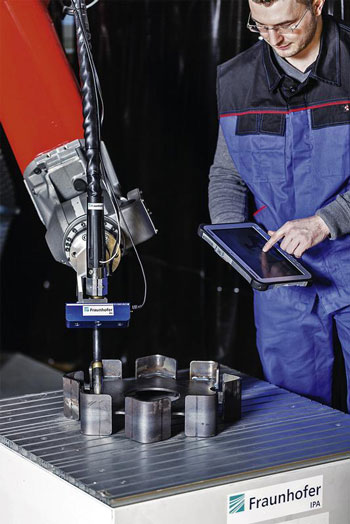| Mar 18, 2014 |
Cognitive and collaborative: CoWeldRob - the welding robot assistant
|
|
(Nanowerk News) It can localize components, automatically generate programs, learn from the worker and collaborate with him. For the European research initiative SMErobotics, scientists at Fraunhofer IPA are developing a cognitive and collaborative welding robot assistant called CoWeldRob. The goal is to significantly reduce the programming effort for automated production in small and medium-sized welding businesses. A welding robot cell for welding typical components will be demonstrated at Automatica 2014.
|
|
Solid expertise combined with many years of experience: that’s what is required for the high-quality production of welded components. The welding torch needs to be accurately controlled with expert skill and the correct welding sequence must be observed. On the other hand, the working conditions for humans are exacerbated by such factors as air pollution, heat and non-ergonomic posture. Also, as there is a growing shortage of qualified skilled workers, one possible solution might be to transfer the existing technological know-how to robot systems. So far, however, automation has been made impossible by the high programming effort required for robot systems, especially in small-scale production and where there is high product diversity, such as in small and medium-sized manufacturing enterprises. What is needed is a robot system capable of independently generating suggestions for task or program execution, continuously learning from the human worker and applying the acquired knowledge to similar components.
|
 |
| CoWeldRob – the cognitive and collaborative welding robot assistant.
|
|
CoWeldRob
|
|
The European research initiative SMErobotics is developing new modular and interactive operating concepts and control systems for the efficient use of robots in a variety of applications. With this in mind, Fraunhofer IPA is designing and developing a cognitive and collaborative welding robot assistant known as CoWeldRob. The goal is to significantly reduce the programming effort for automated production in small and medium-sized welding businesses.
|
|
“CoWeldRob is designed to make the automation of welding operations profitable also in the case of small lot sizes and production quantities. It does this by being easy and intuitive to program by the welder and by continuously learning from him,” explains Thomas Dietz, project manager and group leader in the Robot and Assistance Systems department.
|
|
The welding robot assistant can automatically transfer programs to similar components without the need for major new programming effort.
|
|
“This allows above all small and medium-sized enterprises to respond more flexibly to changes in customer orders,” says Dietz.
|
|
At Automatica 2014, Fraunhofer IPA will demonstrate a welding robot cell for cost-effective path welding based on the example of steel components from the agricultural machinery sector, including for extremely small lot sizes. Visitors will have an opportunity to specify their own desired welding process and have it executed by the robot system.
|
|
System components
|
|
Automatic, model-based path and program generation: Robot programs are automatically generated on the basis of different models of the components, welding process and robot system. Intuitive operation, e.g. using a touchscreen, pointing or showing, allows changes made by the welder to be quickly incorporated and implemented. Such user inputs as well as sensor-detected data are brought into a logical relationship. This information can then be reused for various downstream processes, such as grinding or quality control. This makes it possible for programming and set-up times to be significantly reduced.
|
|
Component localization: By comparing CAD and sensor data, the welding robot assistant is able to automatically determine the precise position of the component and therefore of the welding paths. This makes it possible to adapt the robot path and to dispense with rigid fixtures for exact positioning of the components.
|
|
Robust handling of uncertainties: The developed approaches are designed to cope with and suitably react to tolerances both of the component, such as air gap and weld preparation, and of the process, such as a permitted torch orientation error. This makes CoWeldRob more robust than a conventional automated welding system.
|
|
Learning robot: A welder knows from many years of experience which settings are required to produce a high-quality component. The process expert can transfer this experience to CoWeldRob by, for example, evaluating a suggested weld seam sequence and by thus instructing the robot system with regard to the desired mode of behaviour. Consequently, using methods from cognitive research, the robot can learn from the welder’s process know-how and continuously improve its performance over time.
|

